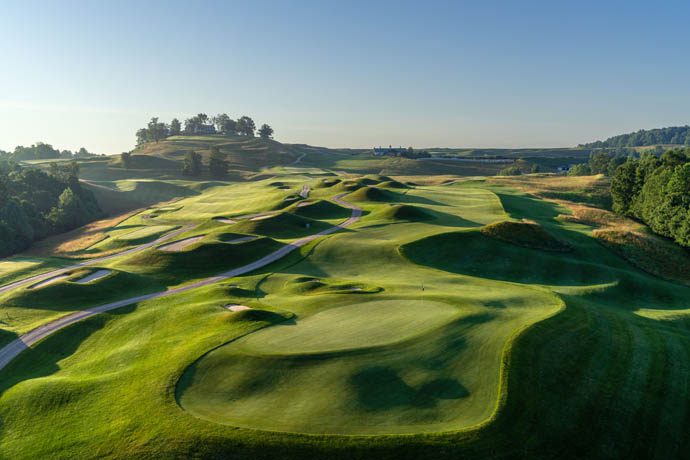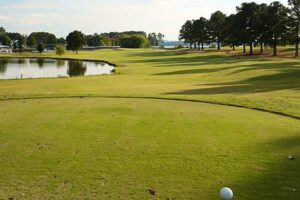Resort is renowned for its two championship golf courses
Most of the locals in French Lick have a Larry Bird story.
They either knew the NBA legend or somebody in his family, went to school with them, or knew of the Birds from around town. Some of the stories are likely true – you know how stories take on a life of their own over the years.
What’s not embellished around these southern Indiana parts is French Lick’s golf scene. Saying it’s outstanding is in no way an overstatement.
It starts with The Dye Course at French Lick Resort, moves on to The Donald Ross Course at French Lick Resort, and concludes with Sultan’s Run in nearby Jasper.
Play the trio of courses in any order and you’ll come away wide-eyed and longing for a return trip to this quaint little slice of Indiana that not only is known for being Bird’s hometown, but for its early historical significance.
Originally settled as a French trading post, the area became known for its mineral springs and luxury hotels such as the French Lick Hotel, which dates to 1845, and West Baden Springs Hotel. It has been a playground of sorts for the rich and famous – there are walls and walls of photos of the celebrities who have stayed in the French Lick Hotel.
And while the area’s history is interesting, it’s the golf that makes you want to zip up I-65 through Alabama, Tennessee, and Kentucky before veering northwest to French Lick.
The Donald Ross Course at French Lick
My first visit to French Lick Resort started with an early afternoon round on the Donald Ross Course., which dates to 1917 when it first opened as “The Hill Course.” Lee Schmidt renovated it to its original specs in 2006 and it remains a Ross masterpiece. If it’s history you like, well, the Donald Ross Course has plenty of that starting with Walter Hagen beating James Barnes on the 36th hole to win the 1924 PGA Championship – a win that was worth $6,830.

The course history doesn’t stop there, though. Pete Dye – more on him later – won the 1957 Midwest Amateur Championship on the Ross Course and Louise Suggs won the first French Lick Women’s Open just one year later. The Ross Course also hosted the 1959 and 1960 LPGA Championships,
Aside from its history, the Ross Course is a classic Donald Ross design that meanders across the Indiana hillside. It features deep ravines, ridges and valleys and traditional severely contoured greens for which Ross was known.
Ross designs rarely wow players with their length. The par-70 Ross Course tips out at 7,030 yards, while the bronze tees (6,517 yards, 73.0/146) and black tees (5,950 yards (70.4/139) hardly seem overwhelming. Those yardages are deceiving. The Ross Course plays longer than its scorecard yardage when factoring in the hilly terrain and wind.
Part of Donald Ross’ brilliance is that his courses seem relatively benign until you are trying to navigate them. The Ross Course at French Lick isn’t penal off the tee – wide fairways are the norm. There is plenty of room, but the genius lies in trying to find the right line to set up the best approach to his tricky greens. Often, the correct line brings the most danger into play. Take an aggressive line, make the right swing and there are birdie opportunities galore. But the slightest mis-hit can result in difficult recovery shots.
The Ross Course greens are typical of his design philosophy. Good shots are rewarded, but miss just a little and the ball will slip away from the hole into collection areas or bunkers. Ross put a premium on approach play and putting, and this course is a marvelous example of that philosophy.
I loved the diversity of the par-3s that ranged from 119 to 208 yards (black tees). something rarely seen when playing forward tees.
There should be no hesitation when the opportunity to play a Donald Ross design arises, and the Ross Course at French Lick should be on everybody’s list of must-plays.
The Pete Dye Course at French Lick
The Pete Dye Course, designed by Pete Dye, is easily the most visually intimidating golf course I have played. It’s no wonder why it is widely accepted as one of the toughest and dramatic courses in the country.

The corridors of many holes are played along steep ridges framed by steep drop-offs, deep rough and gaping bunkers. Built on one of the highest ridgelines in the state, the Pete Dye Course offers up panoramic views of nearly 40 miles of the surrounding countryside and bringing an element of the wind into play.
The Dye Course features seven sets of markers, and from the tips it checks in at a mighty 8,102 yards with a course rating of 80.5 and a slope of 151. Yeah – skip those tees. It’s a stout 7,254 yards from the gold markers and 6,701 yard from the blues.
Dye uses optical illusion to deceive you from the tees and for approach shots. The fairways seemingly are just slivers of green bentgrass but are wider than you think. Its pot bunkers are death traps, and with many of the fairway bunkers shaped diagonally, the visual lines for tee shots often leave players wondering just how to get the ball in the short grass.
Greenside bunkers are deep and steep-faced, set well below the green surfaces. Often, just a bit of the flagstick visible as Dye placed yet another measure of discomfort and doubt into the shot. There simply are no easy up-and-ins from the bunkers.

The greens complexes are expansive, firm and undulating, but require precise approach shots. Getting on in regulation by no means ensures two-putt pars, and even some good approach shots will roll off into the surrounds. Many greens are elevated or set on plateaus, increasing difficulty for short game recovery shots.
Like the Donald Ross Course, the Pete Dye Course is going to test every facet of your game – especially the mental aspect. It’s built for championship golf and there are no holes where a person can relax. Can it be frustrating at times when good shots finish in bad places? Sure. But when you do tame the Pete Dye Course at French Lick, it is so, so satisfying.
Sultan’s Run Golf Club
Although technically not a part of French Lick Resort, Sultan’s Run is a wonderful 18-hole layout about 30 minutes away in Jasper that has a partnership with the resort. Originally opened in 1992 on the site of the Rucker horse farm, Tim Liddy, a Pete Dye disciple, renovated it to its current layout in 1996.
The course name stems from Supreme Sultan, a world champion American Saddlebred stallion and each of the 18 holes pays homage to a former champion bearing the horse’s bloodline. Plaques sdisplay each hole’s namesake.
While the French Lick courses are routed through open spaces, Sultan’s Run winds its way through the rollingwoodlands and feature water and wildlife. It has zoysia fairways fescue/Bermuda rough and bentgrass greens.

Like the French Lick Resort courses, elevation changes make for a variety of demanding uphill and downhill shots. And Liddy did an excellent job using ponds and creeks to enhance the difficulty.
Sultan’s Run isn’t long by today’s standards, playing 6,859 yards from the tips. Five other sets of tees ranging from 4,911 to 6,429 yards give players of different skill levels plenty of options. Unlike the Dye Course, Sultan’s Run is not going to beat you up. Risk-reward opportunities are plentiful on some of the short par-4s.
The closing hole – Supreme Sultan – is one of the most picturesque in the state with a green framed by a 25-foot waterfall and rock wall. It’s a memorable way to close out a round at Sultan’s Run.
Co-owner Chris Tretter classifies Sultan’s Run as a boutique resort, and said the course continues to evolve through undergrowth and select tree removal. There are three houses bordering the course – two that recently opened that are owned by the club for stay-and-play packages. More cottages are planned to enhance the appeal of the property.
The full-service clubhouse has been recently renovated, and Tretter said he would like to add nine holes or acquire another nearby 18-hole course to enhance Sultan’s Run as a stand-alone resort.
For a course that has received more than its share of accolades from golf and travel publications, Sultan’s Run is a perfect complement to French Lick Resort with a price point of $95 during the week and $115 on weekends.
French Lick Resort Amenities
In addition to the Donald Ross and Pete Dye courses, the resort features the nine-hole (with plans to expand to 18 holes) Valley Links Course designed for families and children. It features rolling fairways, Scottish-style fescue grasses and strategically placed bunkers.
The most recent addition is the Sand Creek Course, a nine-hole short course with no hole over 90 yards. Features such as Dye’s volcano bunkers and Ross’s contoured greens add a measure of challenge. It’s a perfect way to start or end the day at the resort.
There are 12 restaurants spread across the resort, ranging from fine to casual dining. There are three hotels and the casino offers every variety of gaming.
And who knows, maybe you will run into someone who has a Larry Bird story.
Gregg Dewalt is the Editor of Alabama Golf News
Featured image of The Dye Course courtesy of the French Lick Resort
Have a story idea or a news item to report to Alabama Golf News? Email editor Gregg Dewalt at bamagolfnews@gmail.com







